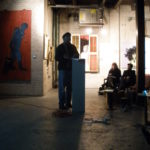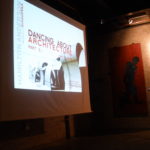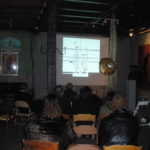CRAIG WILKINS POST LECTURE DISCUSSION
“Writing about music is like dancing about architecture – it’s a really stupid thing to want to do” -Elvis Costello
lecturesHAA : Event 4. With the tempo of a beatnik and a black turtleneck sweater to match, Craig Wilkins free-formed one December evening before an intimate crowd at the Johanson Charles Gallery. Neither traditional presentation nor musical jam session, his lecture entitled “Dancing about Architecture…Part 3”, ebbed and flowed in accordance with the accompanying music. Miles Davis. Nelly. John Coltrane. Lil’ Kim. Brazilian Salsa. Public Enemy. Each musical style provided a unique lens in which to view an architect’s design process and their resulting built form. Brazilian Salsa directly influenced Gaudi’s Parc Guelle. Josephine Baker provided inspiration for both Adolf Loos’ Villa Baker and Le Corbusier’s City of Algiers. James Brown infiltrated South America, thereby evolving the favelas of Brazil. Hip Hop music prompts Rural Studio and the dramatic sampling of found materials.
Dancing about architecture. As the fourth presenter in the lecturesHAA series, Craig Wilkins has worked internationally as a designer, project architect, urban designer, and academic. Providing history for his lecturesHAA topic and further clarifying the “…Part 3” portion of his lecture title, Dr. Wilkins explained that he has previously written and lectured extensively on hip hop architecture and “The Aesthetics of Equity: Notes on race, space, architecture, and music.” His December 15th discussion expanded these previous investigations. Wilkins immediately acknowledged that in the most simplistic terms, architecture can take a literal form of music…imagine a rock n’ roll museum in the shape of a guitar or treble clef. However, providing a catalogue of crude musical interpretations was not the goal of his lecture. Instead, he analyzed the musical genres of jazz, salsa, and hip-hop, ultimately proposing that architects should evolve their own antiquated design process by implementing specific portions of the musician’s creative process.
Discourse about architecture. As with all previous lectureHAA presentations, the lecture initially acts as catalyst, opening a stream of consciousness that persists for days…sometimes weeks. In this case, how could architects emulate the musician’s creative process? How would this emulation evolve the profession of architecture? How would this evolution transform architectural space? While the discourse was lengthy and somewhat scattered between the Charles Gallery, Bert’s Pub, and then amongst various Detroit design circles, the following disparate concepts emerged:
Singularism: Evolving architectural pedagogy from a singular, closed-loop system. Within the first days of a classical architectural education, the architecture student is molded to singularly produce, present, and protect their design work. As an extension of their psyche, a student’s work represents their soul. At the culmination of each semester, each student presents their individual work to a jury of more experienced architects, who either praise the project and/or barrage the pupil with pointed questions that always reveal the works’ discrepancies. After repeating this rigorous cycle numerous times, it is no wonder that the architect develops an ego. More importantly, the student subconsciously identifies the architectural creative process as being a closed-system.
Altering this introverted pedagogical approach to include mandatory collaborative design efforts would transform the world of architecture. Furthermore, the requirement of multi-disciplinary student projects would instill a greater value for each project team member, regardless of occupation, scope, or design responsibility.
Pluralism: Reinterpreting architectural collaboration. By emulating the creative dialogue between working musicians, architects could actively reinterpret the nature of collaboration within the architectural practice. Instead of imposing the more traditional closed design process of a singular architect’s ego, collaborative design could result from an open exchange of ideas amongst colleagues, with each participant building off the strengths and weaknesses of their teammates, much like jazz musicians in a jam session. This change in process would have a profound effect on architectural form and discourse.
Activism: Architecture and Advocacy. As previously stated, a collaborative architectural process would allow for greater design freedom within a radically different, multi-disciplinary composition. However, this plural approach could further evolve through a more flexible framework, a deviation from the traditional for-profit architectural environment. As described in Aaron Taylor’s previous post on pro-bono architecture, architectural critic Clay Risen, calls for a dramatic reversal of the profession, eliminating the ego-centric design process. While legal and medical professions have already established professional frameworks guiding their pro-bono practices, architects are just beginning to define how to work in this way.
Conclusion. So following Dr. Wilkins’ lecture, we ask ourselves, what would result from improvisational collaboration? Can the architectural process be performed rather than composed? Can we pluralize our profession? And lastly, doesn’t the Detroit design community already operate within this collaborative design process?







